How to Give a Cat a Bath: Pro Tips Make It Less Stressful for You and Your Feline
Plus, the best way to set up your bathing station
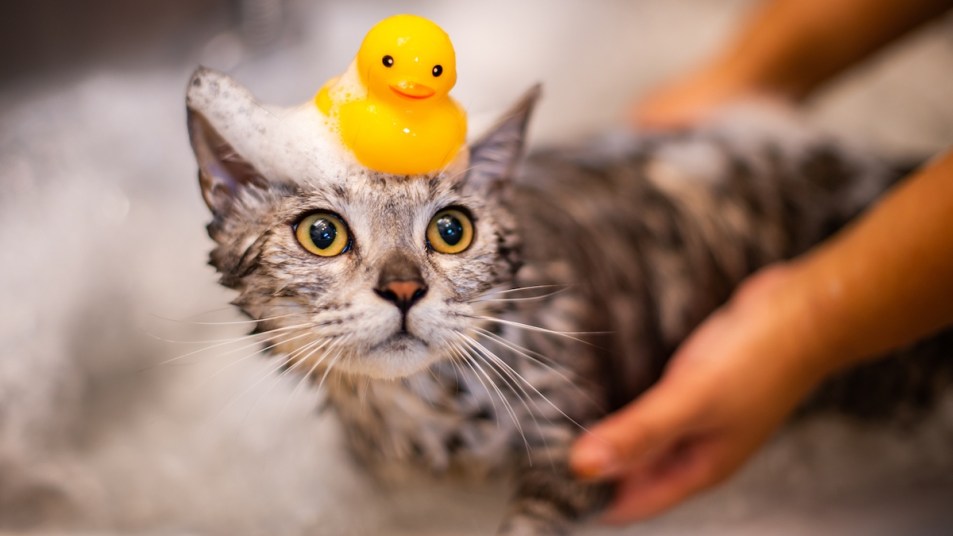
Giving a dog a bath is often pretty straightforward — just soap them up and hose them down. But cats are a whole other animal. And while it’s true that felines do a better job of cleaning themselves with their tongues than dogs, there are a few instances where they might need a proper bath. Trouble is, they are way more likely to be finnicky around water. How to give a cat a bath while keeping both you and your pet happy and safe? Read on for pro tips that make it stress-free.
Do cats need baths?
It’s rare that a domestic cat needs to be bathed as a frequent part of their grooming routine. Essentially, their tongues are covered in sharp little spines called papillae, which give them that rough, sandpaper-like feel. Those papillae feature hollow cavities that thrust saliva onto the cats’ hair. This is why cats are mostly able to take care of their regular grooming needs themselves.
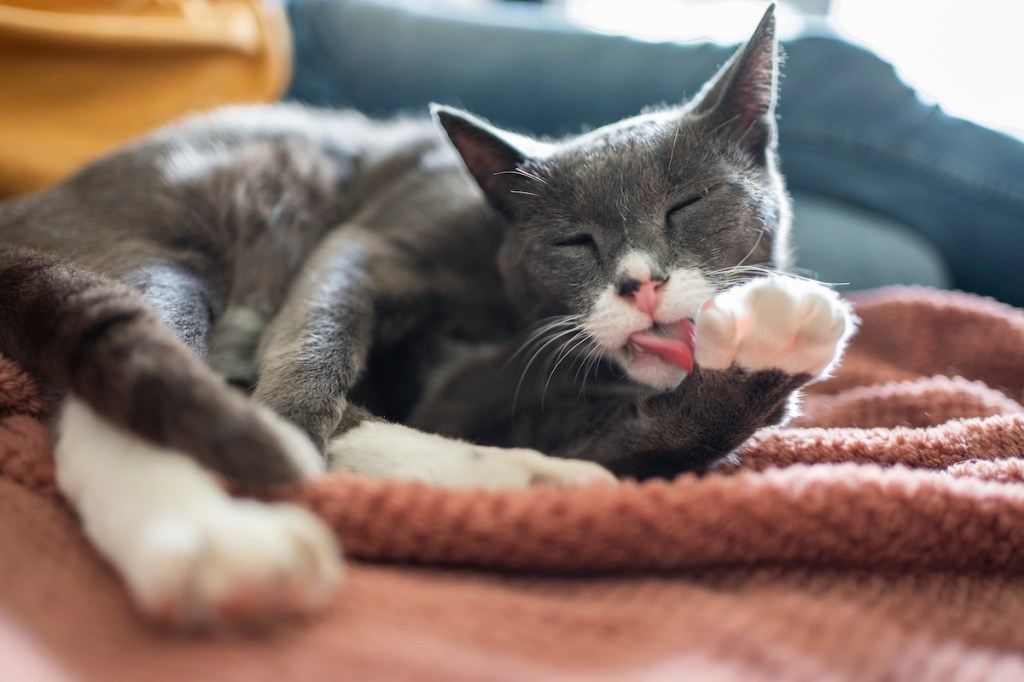
That doesn’t mean a bath can never be beneficial, and sometimes it’s even necessary. Once a cat gets particularly dirty, or if they have a skin or coat condition, licking themselves won’t provide the deep clean they need.
When to give a cat a bath
So, what exactly are the circumstances that would make it worth the effort to give your cat a bath at home? There are three instances where it may prove beneficial.
1. If their skin and coat require it
It’s best to be able to wash your cat thoroughly with soap and water if they contract fleas, allergies or conditions that cause dry and flaky skin. Also, cats are famously curious and might end up getting into something that gets them too dirty to fully clean themselves.
Mikel Maria Delgado, PhD, cat behavior expert with Rover, says while she has never bathed her cats since they do such a good cleaning job themselves, there are rare times when your cat might need a bath, like if they have a bladder disorder and have soiled themselves. If a cat has any sort of incontinence issue, feces and urine could easily end up on their fur and skin, which could lead to irritation, sores and if not treated, possibly infection.
2. If their breed calls for it
Feline experts say that “hairless” cat breeds like the Sphynx need routine bathing. That’s because the oils on their skin can’t be whisked away by their fur like most other breeds. Other hairless breeds that need more frequent bathing include the Bambino, Dwelf, Lykoi, Minskin, Peterbald, Ukrainian Levkoy and Oriental Shorthair.
3. If they are so overweight, they need help with cleaning
Stephen Quandt, feline behaviorist and founder of Stephen Quandt Feline Behavior Associates, also points out that overweight cats might not be able to self-clean if their size makes it challenging for them to reach certain parts of their body.
“Most cats don’t need baths if adequately groomed, combed and maintained,” adds Grant Little, DVM, a veterinarian and expert for JustAnswer. “Cats who are the appropriate weight can easily groom most of their fur, but as they get larger, they can’t do this. Reducing cat obesity will help with grooming in general.
Important note: “Cats can also have medical conditions that lead to poor hair coat,” says Dr. Little. “If there’s a poor hair coat, I highly recommend working it up with your veterinarian to assess for allergies, skin diseases, or internal endocrine issues.”
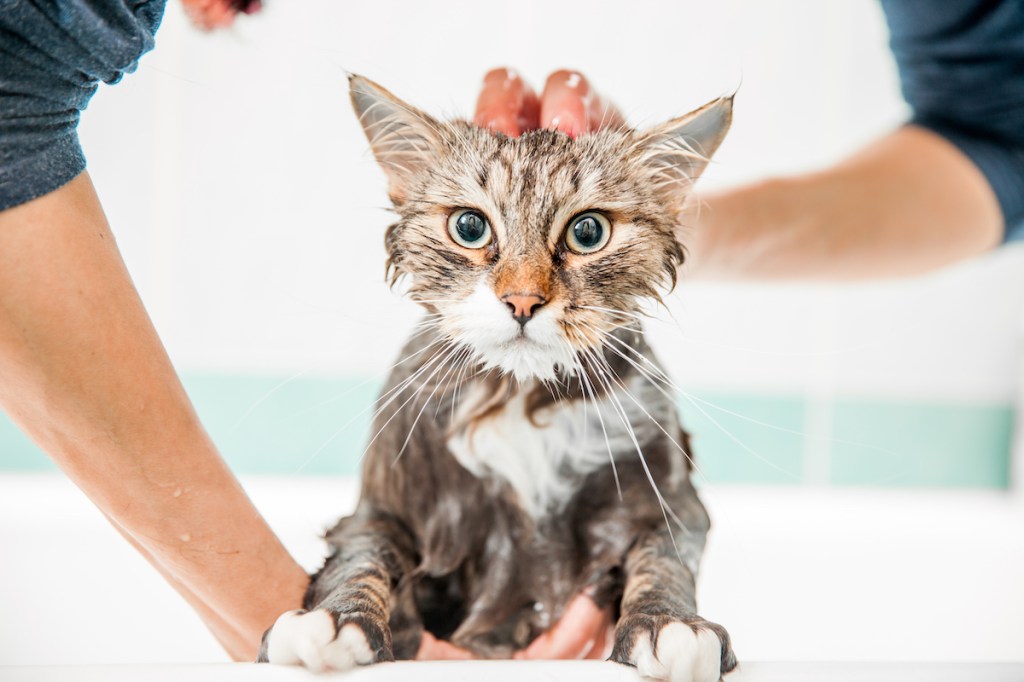
Don’t bathe your cat to soothe human allergies
If you or someone in your home is allergic to cats, you might consider a bath to fight off allergens, but Dr. Delgado says this isn’t a good idea. Instead, she says, keep the cat off furniture and out of spaces like the bedroom. Also, thoroughly wash and clean any surfaces or areas they frequent to get rid of shed proteins and dander (the cause of allergies), minimize dander-trapping fabrics in the home like rugs and curtains, use air filters and purifiers, and wash your hands immediately after touching the cat.
How to give a cat a bath
If you find yourself needing to give your cat a bath, follow these four steps for success.
1. Set up the bathing station
Julia Benning, Grooming Advisory Board Leader at Well Groomed Pets, suggests placing the cat in the sink as opposed to a bathtub if possible when giving them a bath, as there won’t be as many opportunities for the cat to escape in the smaller, more enclosed space. If you do decide to bathe your cat in a bathtub, she says, it can be helpful to use a smaller plastic tub — something the size of a litter box or baby bath — and place the smaller container in the bathtub. A non-skid mat underneath the cat can also help to ensure they don’t slip or lose their balance.
“It’s also helpful if there is an area of the tub without water to give your cat the choice to enter the water slowly, and gently place them away from the deepest area of water,” Dr. Delgado offers. “This isn’t like a bath where humans might lounge and relax for a long time.”
The TikTok below shows an effective way to set up for bath time:
@purrfectioncatgrooming #catbath #catgrooming #catsoftiktok #purrfectioncatgrooming #catgroomer #batheyourcat
♬ Ameno Amapiano Remix (You Wanna Bamba) – Goya Menor & Nektunez
2. Wet the cat carefully
Benning suggests making an effort to fully brush and comb the cat’s fur before they get wet to avoid trying to wash and dry a tangled coat. Washing a cat when they have tangles will make the tangles tighter and harder to remove, she explains, adding that matted fur can retain moisture and eventually lead to skin infections.
Avoid letting water run directly on the cat’s face, make sure it isn’t too cold and use a washcloth if you need to wash the area, Benning says. If the cat seems distressed by the running water, you should try using a cup and gently pouring water over them.
“If your cat seems to tolerate the shower head or hose, use the most gentle setting and keep the nozzle close to the skin rather than holding it 6 inches away from the skin,” she explains. “Keeping the nozzle close to the body doesn’t feel as scary for most cats.”
Hannah Shaw, a cat care expert more widely known as “Kitten Lady,” is a professional kitten rescuer and the author of TINY BUT MIGHTY: Kitten Lady’s Guide to Saving the Most Vulnerable Felines. On her YouTube channel, Shaw posts videos and tutorials for bathing her tiny, orphaned rescues who are just three to four weeks old and beginning to find their way around the litter box.
She fills the sink up a little bit and plugs it so she can just dip the dirty area into the water, advising to never wet more of the cat than is needed. This way you can help minimize their stress.
3. Wash with gentle but effective shampoo
Shaw suggests using dish soap (which helps break down oils) or a gentle and unscented baby shampoo to scrub the affected areas on the cat, and Quandt recommends diluting the shampoo (unless it is medicated) so it’s easier to rinse off. Try to look for cat-specific shampoo, and steer clear of using regular, adult human shampoo on a feline, which can harm and dry out their skin.
Benning emphasizes the importance of thoroughly rinsing the cat after soaping them up, as leaving product or residue on the cat can cause skin irritation and could lead to needing a second bath.
4. Dry the cat once they’re clean
“You have to be really careful when bathing these little guys because they can’t regulate their own body temperature,” Shaw cautions of the young kittens in her video. “So you have to do it quickly in a way that’s warm and doesn’t stress them out.”
To ensure she can immediately warm the cats up after they come out of the water, Shaw places a heating pad under their blanket before even beginning the bath so it’s warmed up and ready for them as soon as they come out of the water.
“After a bath, place your cat on a towel, and pat them dry,” says Dr. Delgado. “Rub their fur gently until you have gotten most of the moisture out of their fur. Let them air dry in a warm room. A hairdryer is going to be too scary for most cats and can burn your cat’s delicate skin.”
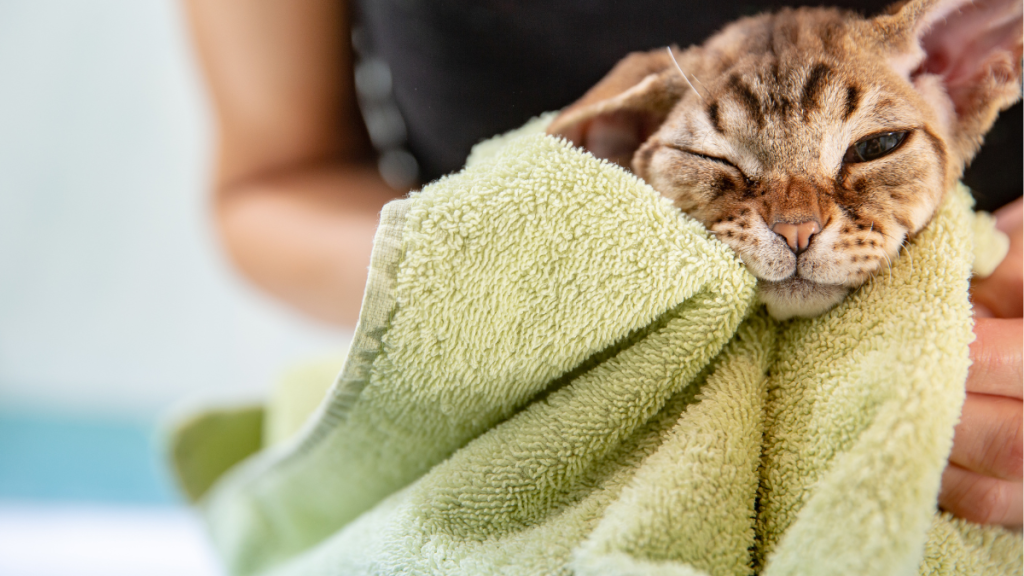
Keeping your cat safe during bath time
With the exception of a rare cat who loves water, you are probably working with a cat who will not appreciate a bath. The last thing you want is for the cat to be miserable or panic. It could hinder your relationship with them, and in the worst case, one of you could get seriously injured. If possible, it might be helpful to have a second pair of hands helping during the bath so one person can be designated to help soothe to the cat, distract them and give them praise and treats for cooperating.
Dr. Delgado also stresses the importance of taking breaks as needed. If the cat seems to be in distress, she says, you should never force it to continue the bath or grab it by the scruff. Instead, stop what you’re doing.
“Most cats have a metaphorical timer. They may be patient for five minutes and then their patience timer runs out and they are done,” Benning says. “Some cats may be patient and calm for 15 minutes before they freak out. We must respect these moments — cats are so sensitive that if we push them when they’re over their limit, the risk of injury increases for both the cat and the person bathing them.”
Some options Benning suggests trying to keep cats as calm as possible during a bath are placing a calming band over their head to help make them feel secure and protect their ears, or using pheromone spray in the room where you are bathing and in the space they go to after the bath to help them relax.
Keeping yourself safe while bathing a cat
Quandt says that you might benefit from tiring the cat out a bit by interacting and playing with them before the bath. He also suggests having their nails trimmed for the best chance of giving your cat a bath without getting scratched.
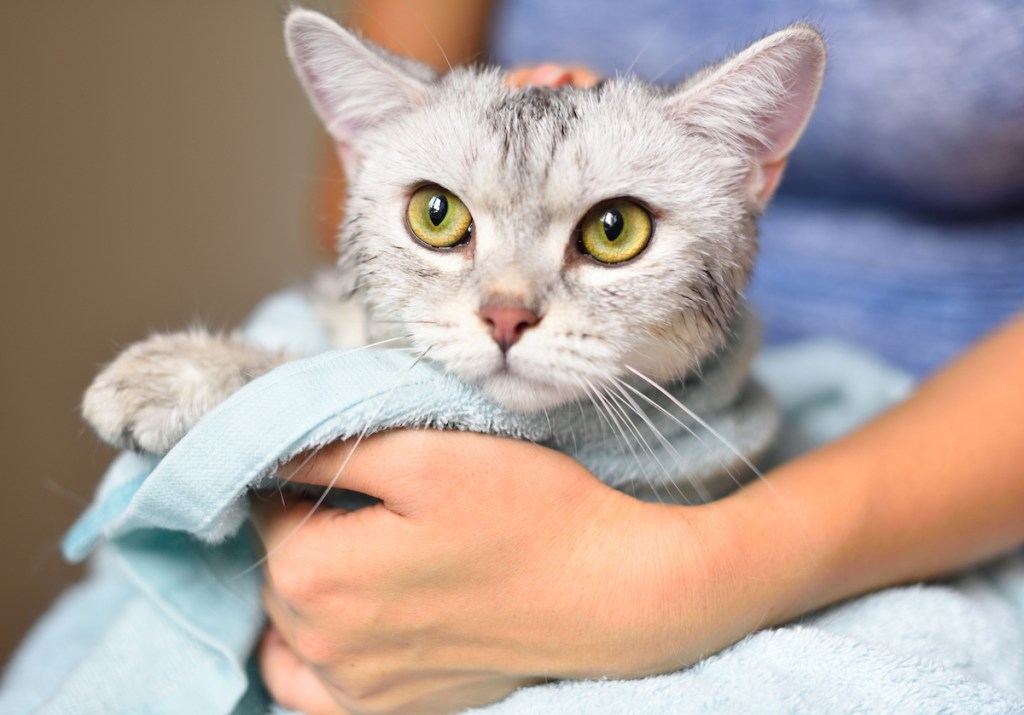
“It’s important to first be calm yourself, because if you are stressed out with the bathing, then your cat will pick up your anxiety,” says Sylvie Sterling, CEO and founder of Feline Soul Academy. “Stay calm and ideally talk to them, like you would to a person, explaining what’s going on and why this is necessary. You can use something like Rescue Remedy drops before the bath, so they’ll be more relaxed and calm. Stand beside or behind the cat, and never in front of the cat when you do this for the first time. Otherwise, they might claw you trying to get out.”
With all of these pro tips in mind, giving your cat a bath will be easier than you might expect!















